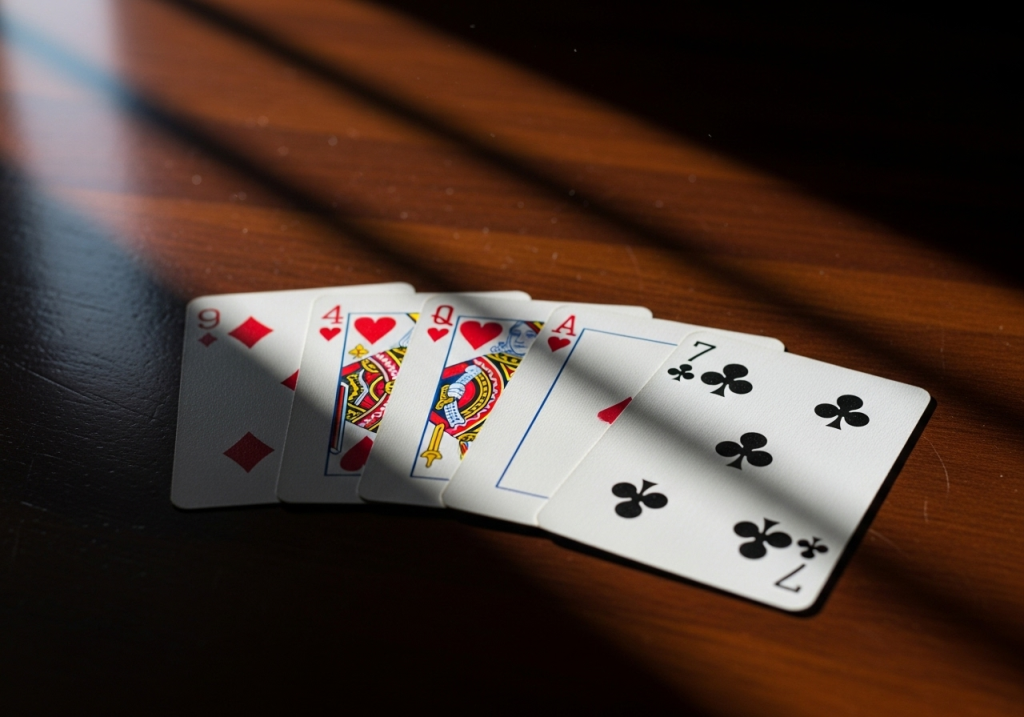Hi, it’s Randy Charach! Thank you for visiting this site! Below is a mentalism ‘trick’ you can do to blow people’s minds.
If you have seen me perform and feel I deserve a 5 Star Review, please take a minute and leave a review for me, here:
Leave a Review for Randy
If you haven’t seen my show, please watch this 1-minute demo video. If you enjoy it, I would appreciate your review.
Also, feel free to visit my website and contact me anytime for any reason: www.RandyCharach.com
Now, here are the instructions to a cool and easy-to-do mentalism demonstration for you to have fun with:
Mentalism Card Trick: The Power of Four
This is a simple yet powerful mentalism card trick that you can perform with any deck of cards. It requires no sleight of hand, just a little bit of psychology and a good presentation. This trick is perfect for beginners who want to create the illusion of mind-reading.
The Effect
You ask a spectator to think of a card from a small selection you lay out. Without touching the cards or asking any questions, you reveal their thought-of card, creating the illusion that you have read their mind.
The Secret: Psychological Force
The secret to this trick lies in a psychological force. You present a small group of cards, and while it appears the spectator has a free choice, their selection is subtly guided towards a specific card. This is achieved by arranging the cards in a way that makes one card the most likely, yet least obvious, choice.
In the demonstration, the 4 of Hearts is the target card. The arrangement makes the central Queen too obvious, the lone black card (7 of Clubs) stands out, and the end cards (9 of Diamonds and Ace of Diamonds) are often overlooked. This subtly directs the spectator’s attention to the 4 of Hearts.

Steps
- Choose your target card: For this trick, the 4 of Hearts is an excellent choice due to its visual characteristics (red, not a face card, not an ace). You can use any card, but understanding the psychology behind the 4 of Hearts will help you choose others.
- Select four other cards: Choose four other cards that will help to psychologically force the 4 of Hearts. In the demonstration, these were the 9 of Diamonds, Queen of Hearts, Ace of Diamonds, and 7 of Clubs.
- The Queen of Hearts is a face card and centrally located, making it an obvious choice that many spectators will avoid.
- The 7 of Clubs is the only black card, making it stand out and often avoided.
- The 9 of Diamonds and Ace of Diamonds are at the ends, which are often overlooked.
- Arrange the cards: Lay the five cards face up in a row in the following order: 9 of Diamonds, 4 of Hearts, Queen of Hearts, Ace of Diamonds, 7 of Clubs.
Performance
- Introduce the concept: Begin by telling your spectator that you are going to attempt a psychological experiment or a mind-reading demonstration. Emphasize that it’s not about magic, but about the power of the mind.
- Lay out the cards: Fan out the five cards face up on a table or in your hand, ensuring the spectator can clearly see all of them. Maintain the specific order you set up.
- Instruct the spectator: Ask the spectator to silently think of any one of the five cards. Emphasize that they should not say it aloud, write it down, or give any verbal or non-verbal cues. Tell them to focus on their chosen card.
- The reveal: After giving them a moment to concentrate, confidently state the name of the 4 of Hearts. For example, you could say, “I’m getting a strong impression… you’re thinking of the Four of Hearts.”
Tips for Success
- Confidence is key: Your presentation is as important as the trick itself. Act confident and mysterious.
- Don’t force it: If the spectator chooses a different card, don’t panic. This trick relies on psychological influence, which isn’t foolproof. Have a backup plan or simply acknowledge that their mind is too strong to read today.
- Practice your patter: Develop a smooth and engaging story to accompany the trick. This will distract from the method and enhance the illusion.
- Never repeat: As with most magic tricks, never perform the same trick twice for the same audience. Once they know the method, the magic is gone.
- Vary your cards: While the 4 of Hearts is a good starting point, experiment with other cards and arrangements to find what works best for you. The key is to understand the psychological principles at play.
Troubleshooting: When the Spectator Doesn’t Pick the Force Card
If the spectator doesn’t pick the force card, you can acknowledge their choice and then transition to a different trick, or simply state that their mind is too strong to read. The key is to maintain your composure and confidence, and not let the audience know that your initial prediction was incorrect. You can also offer to try again with a different set of cards, or move on to another mentalism effect.